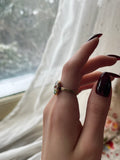Essex crystal pieces are made from a piece of rock crystal, polished by hand repeatedly to create a domed cabochon with a flat base or back. A design is drawn on the flat side and is delicately hand-carved into the crystal, and then painted in reverse by a masterful maker. This is quite unlike normal intaglio, which is painted on the front, as everything has to be done in reverse and from the back. Painting directly into the carved inside of the dome gives the paintings an incredible three-dimensional or '‘trompe l’oeil' effect. Finally, the piece would be sealed with a backing, with early examples being backed onto gold foil, and later examples in mother of pearl and gold. The process involved in producing the pieces was extremely labor intensive and required a very high level of skill.
To understand the story of the Essex Crystal, the first thing to know is that miniature portrait pieces, particularly miniature enamels, were very popular in the Victorian era. Queen Victoria herself was actually so enamored with the style that she appointed herself a royal enameler in 1839. His name was William Essex. When in the mid-19th century reverse intaglio crystals began to appear on the market in Britain, the most famous and most skilled known miniature painter around was William Essex. It was his name that was on everyone's lips and it was assumed that these pieces, requiring such exquisite talent, could only have been created by such a celebrated miniature enamellist as Essex. This rumor was fed by the fact that one of Essex's students, William Bishop Ford, was known for creating enameled pieces set in jewelry with depictions of a fox head, which was a popular motif in Essex crystal jewelry. The name stuck, and the pieces became known as Essex crystal pieces, as they still are today - despite their having nothing at all to do with William Essex.
Source: https://www.antiqueanimaljewelry.com/post/essex-crystal-jewelry
Converted from a cufflink found in London, this darling ring sports a tiny scene of a horse jumping over a body of water, known as a "Liverpool Jump". Colorful and detailed, it will be a great topic of conversation amongst the Horsey Set (and of course, the Jewelry Set)!
Details (approximate)
Size (can be resized): 7
Materials: Gold, Reverse Intaglio Under Glass
Metal: 9K yellow gold (original element), 14K gold (shank)
Marks: None
Condition: Very good converted antique condition commensurate with age and wear













